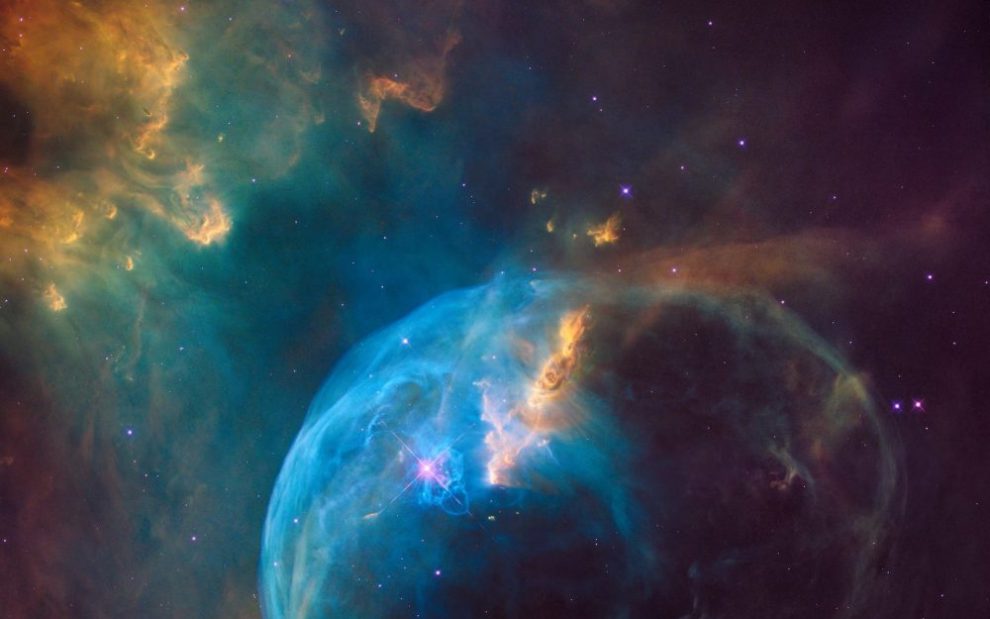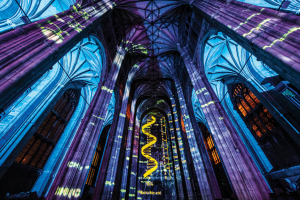
In her debut novel The God Painter (Stone Table Books, an imprint of Wipf and Stock, 2021), Toronto writer Jessica Pegis imagines a recreated Earth on another planet with different opportunities and priorities but the same perennial human conflicts, both cosmic and petty. “A Wrinkle in Time was definitely my favorite book as a kid,” Pegis says. “I used to shine my flashlight at the stars, convinced they would give up their mysteries to me.” As an adult novelist, Pegis is still shining her flashlight at the stars. The plot of The God Painter raises important questions about how we envision the divine—and how this affects our understanding of our own humanity and our responsibility to one another as community and church.
Prior to writing The God Painter, Pegis worked as an editor for over 30 years. She has degrees in English and philosophy from the University of Toronto, and her nonfiction work has appeared in U.S. Catholic as well as in the Toronto Star, the Financial Post, Eye Weekly, and Xtra.
For readers unfamiliar with The God Painter, could you briefly outline the plot and describe the main characters?
The story opens with a lethal solar flare that destroys the Earth. But right before the flare, all the inhabitants of Earth, including plants and animals, are rescued by seven mysterious beings who transport them across the universe to a galaxy light-years away. There, life as it was on Earth is recreated—but with a few innovations, such as a high-tech machine that basically controls the atomic structure of almost anything. The inhabitants can use it to make a house, or make dinner, or whatever they need. What this means is that scarcity is eliminated.
What was your motivation behind creating a world without scarcity?
My idea originally was if you eliminated the scarcity and set everybody free, some people would fear this freedom, and others would welcome it—which is exactly what happens with the other contentious issues in the book.
Eliminating scarcity seems to improve quality of life for everyone. Even work itself does not disappear because work, when performed in a setting of support and unlimited resources, is satisfying to a lot of people. The more you take away the “work” of pure survival and allow people to engage in what is truly of interest and value, the more successful the society. People who insist that being poor is character-building probably haven’t experienced unremitting poverty where you’re expending a lot of energy just keeping yourself from the edge.
The novel focuses on two people who become friends in this new world. Joy is an artist in her mid-30s who had recently broken up with her girlfriend, partially because art really consumes her. Leo, who works for the Vatican, is in his late 50s and recently widowed. He is very progressive but has become rudderless since the death of his wife. Joy and Leo meet because he notices her sketching, and because she has made herself an unusual home, a copy of the Lamberti Tower.
The two become close friends, but not in a romantic way. And Leo watches Joy as she grapples with the mysteries of this new world, especially a vision she has had of a strange green Eden-like space off in the distance.
What did you have in mind when you created the relationship between Joy and Leo, who are very close, but not in a romantic or a sexual way?
In one sense, they are like a new Adam and Eve. In the scene when Leo first meets Joy, he says, “We live at the beginning of time.” But at the same time, they’re not preoccupied with any of the things Adam and Eve were preoccupied with. They live in the fallen world, and their relationship will never be physically intimate, though they have a deep personal intimacy.
I think the church needs to pay attention to such relationships and to the capacity for men and women to have close friendships. Both Leo and Joy are single. The church really gives short shrift to single people by expecting everyone either to enter religious life or to find a romantic and sexual relationship.
Can you talk about how Joy both does and doesn’t fit the trope of the “strong female character”?
I believe characters should be people above everything else. Even though Joy and Leo are not a couple, they can be understood in relation to each other. Leo is really a ditherer. But Joy, even before they are relocated, has been freeing herself from things that tie her down, so she just throws herself into everything. She builds the tower. She immerses herself in her art.
She’s madly in love with Gala, one of the beings who rescued them. And she’s fascinated by the mysterious garden she keeps seeing, which clearly doesn’t operate according to the rules of normal ecology. Joy is determined to understand this and keeps pushing and pushing until she kind of falls into the sublime.
But no, she never wears a power suit or anything like that, and she’s quite vulnerable because of her earlier history.
The main conflict in your novel arises when conservative factions in this new world become suspicious of their rescuers, because they appear to be intersex or nonbinary. Why did you decide to create this sci-fi backdrop for a conflict that could play out in our world?
Part of it is that I always imagined this story as starting with a rescue. I’m not usually inspired by the idea of creating a world first and a plot second. The story has to be character and plot driven. And taking the plot away from our Earth allows us to test some of religion’s claims about universals. I’m not trying to put anything under the microscope, but I am exploring how people react if you place them in certain circumstances.
There are these incredible creatures who guide the human characters patiently—but are they good or evil? The idea is to unsettle everything, unsettle the people in the book, unsettle the reader. Quite frankly, in religion, there’s too much certainty and not enough unsettledness.
In one sense, the characters are acting the way they would on Earth, but removing them from their usual context really highlights the different ways people perceive events and react to them. So the people who have been rescued have this incredible advantage now but still stump for the same old tired issues. They still say, “We must preserve these things. They’re essential and they’re the best for everyone.”
How do you think speculative fiction, fantasy, and sci-fi allow us to explore these religious and moral questions?
Religion occupies the space of myth and mystery just as much as it encourages right behavior and beliefs. I recently read a piece in the National Catholic Reporter about two books examining the decline of organized religion. One of them said that one problem with religion is that it too often boils everything down to a recitation of beliefs and ignores the mystery. Speculative fiction gives us a chance to recover the mystery.
Someone like C.S. Lewis, for instance, looked to different historical eras to create his fantasy. You have ancient Greek and Roman myth, but also knights, kings, and queens, who seem to come from the medieval era. And he did that to tell the story of faith in a fallen world and, ultimately, resurrection. Because speculative fiction can go back in time and explore the mysteries of the past or look forward to the mysteries of the future, I tried to combine the ancient with the modern in my world.
U.S. Catholic has published articles about the importance of having more diverse images of the divine, and we know God is beyond sex and gender, though we use gendered metaphors for talking about God. But some Christians seem to think we must envision God as male. What are the benefits of having an image of the divine as nonbinary or intersex, as you depict your rescuers?
One of the rescuers, Gala, tells Leo that their intersex bodies reflect the divine intention regarding humanity. Though I should caution that they’re not intersex in the way that any intersex person would be. In humanity, if you are intersex, you have nonredundant male and female sexual organs. But these beings have complete sets because they are intended symbolically. I think that the image of an intersex or nonbinary God mirrors the wonderful variation in humanity. It also goes back to old myths, as in the midrash, about the first human being having been a hermaphrodite or androgynous.
We have these ideas about the feminine and masculine principles, or traits associated with masculinity and femininity. And a balance is achieved when they’re together. A fully human person is a balance of so-called masculine and feminine traits. We need to be encouraged to develop both. That’s how you become a full human being. That’s how you show forth the image of God.
Many Christians seem to think the only way to achieve the blending of the masculine and feminine is through heterosexual marriage. But this is a limited way of looking at what the blending of masculine and feminine means. The potential to be both is a divine stamp on every human person. A number of people have suggested that Jesus Christ was the perfect embodiment of the masculine and the feminine. If you go to my website, you can find many images of the divine as androgynous. Some of them are pagan, but one is a painting of Jesus Christ in Belgium, which depicts him with breasts.
What’s the main thing you’d like a reader to take away from your book?
I’d want them to feel that sense of mystery that comes with being deposited in a new place and learning that reality may be bigger and more open than we originally thought. To think of the Christian message as truly universal, i.e. across the universe, is mind-blowing because it’s not just for humans. It’s for everybody.
Image: Unsplash/NASA















Add comment